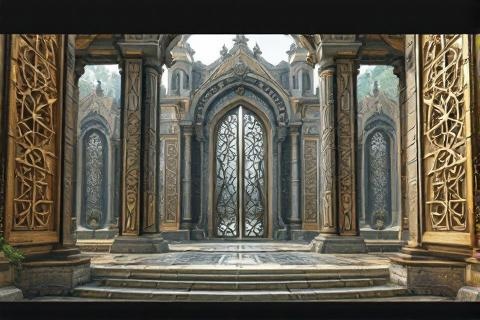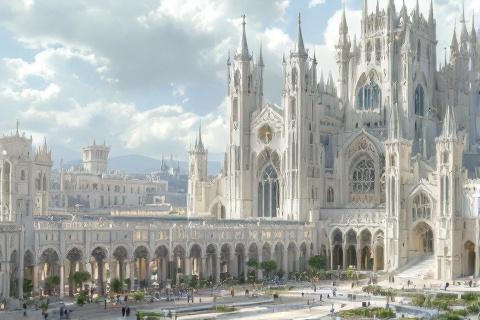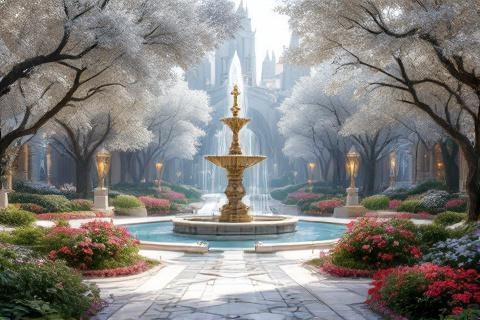
Gondolin: The Hidden Jewel of Middle-earth
Unraveling the Rise, Glory, and Fall of Tolkien's Legendary Elven City
The Vale of Tumladen

Hidden deep within the Encircling Mountains of Tumladen, Gondolin's location was
chosen with utmost strategic care by Turgon after Ulmo's guidance in a dream.
The city lay in a valley surrounded by the near-impassable peaks of Echoriath,
making it virtually impervious to discovery by Morgoth's
forces. The secret location, reached only through a hidden passage in the
mountains, remained concealed for centuries, protecting its inhabitants from the
growing darkness in Middle-earth.
The valley of Tumladen stretched around Gondolin in a vast circular plain,
providing abundant resources for the city's inhabitants. This fertile region,
watered by streams flowing from the mountains, supported extensive agriculture
and gardens that sustained the population throughout its isolated existence. The
richness of the soil and the temperate climate allowed the Gondolindrim to
cultivate crops, tend orchards, and maintain livestock without requiring trade
with the outside world.
The natural fortifications of Gondolin were further enhanced by the treacherous
pathway known as Orfalch Echor, the only entrance through the Encircling
Mountains. This carefully guarded ravine wound through the mountains in a
complex series of turns and switchbacks, making it easy to defend and nearly
impossible for enemies to navigate. The narrow passage was protected by seven
gates, each more formidable than the last, creating an almost impenetrable
barrier against potential invaders.
The Seven Gates of Gondolin

The Gate of Wood marked the first defense of Orfalch Echor, crafted from the
mighty trees of the ancient forests. This gate, though appearing deceptively
simple, was enchanted with powerful spells of concealment and protection. Guards
maintained constant vigilance at this entrance, which was designed to blend
seamlessly with the surrounding forest, making it nearly invisible to unfriendly
eyes.
Following the wooden gate stood the Gate of Stone, an impressive structure hewn
directly from the living rock of the mountains. This massive barrier stretched
from one side of the ravine to the other, featuring intricate carvings that
celebrated the craftsmanship of the Noldor. The gate's
construction demonstrated the exceptional stone-working skills of the elves,
with perfectly fitted blocks that required no mortar to maintain their strength.
The next three gates represented an escalating display of metalwork mastery. The
Gate of Bronze shone with a warm, golden-brown hue and featured elaborate
decorations. The Gate of Writhen Iron demonstrated complex patterns of
intertwined metal, creating an imposing barrier of black steel. The Gate of
Silver gleamed brilliantly in any light, its surface adorned with delicate yet
strong filigree work that showcased the artistic sophistication of Gondolin's
craftsmen.
The final two gates represented the pinnacle of Gondolin's defensive
architecture. The Gate of Gold radiated with the precious metal's distinctive
brilliance, incorporating gems and elaborate designs that celebrated the city's
wealth and artistic achievement. The Gate of Steel, the last and most formidable
barrier, stood as an impenetrable wall of hardened metal, its surface polished
to mirror-like perfection, guarded by the most skilled warriors of the city.
The Walls and Towers
The walls of Gondolin rose high and proud, their white stone gleaming in the
sunlight like polished marble. These massive fortifications, constructed from
materials quarried from the surrounding mountains, encircled the entire city in
multiple layers of defense. The walls' construction demonstrated the exceptional
engineering capabilities of the Noldor, with each stone precisely cut and
positioned to create an almost seamless surface.
Along these mighty walls stood numerous watch-towers, strategically positioned
to provide comprehensive surveillance of both the surrounding valley and the
city itself. These towers, varying in height and design, housed garrison
quarters for the city's guards and contained signal devices to quickly alert the
city of any danger. The towers' placement ensured that no part of the
surrounding plain could escape observation.
The defensive architecture of Gondolin represented the height of Noldorin
military engineering. The walls incorporated hidden passages, multiple fighting
platforms, and sophisticated mechanisms for rapidly deploying defenders. Arrow
slits, machicolations, and other defensive features were seamlessly integrated
into the aesthetic design, creating fortifications that were both beautiful and
formidably practical.
The Tower of the King

The Tower of the King, known as the Tower of Turgon, dominated Gondolin's
skyline as the tallest structure in the city. This majestic spire reached toward
the heavens, its height allowing observers to see beyond the Encircling
Mountains on clear days. The tower served not only as Turgon's residence but
also as a symbol of Gondolin's power and the authority of its king.
Constructed entirely of white stone, the tower exemplified the finest
achievements of Noldorin architecture. Its walls featured intricate carvings
depicting the history of the Noldor and the founding of Gondolin, while delicate
spires and arches demonstrated the elves' mastery of stone-crafting. Crystal
windows caught and reflected sunlight, making the tower sparkle like a beacon
above the city.
At the base of the tower lay the Square of the King, a grand plaza paved with
polished stone and adorned with fountains. This space served as the heart of
Gondolin's civic life, where citizens gathered for ceremonies and celebrations.
The square's design incorporated symbolic elements representing the union of the
Noldor with the Valar, including motifs of eagles and stars.
The Houses of the Twelve Houses
Each noble house in Gondolin developed its own distinctive architectural style,
reflecting the character and values of its leaders. The House of the Heavenly
Arch incorporated sweeping arches and astronomical motifs, while the House of
the Tree integrated natural elements into their buildings. The House of the
Golden Flower favored elegant, flowing designs with floral themes, and the House
of the Hammer of Wrath constructed robust, fortress-like structures.
The houses were strategically placed throughout Gondolin according to both
practical and symbolic considerations. Military houses were positioned near the
walls to facilitate quick defense, while houses focused on crafts and learning
were located closer to the city center. This arrangement created natural
neighborhoods that fostered cooperation between houses with complementary
functions.
The decorative elements of each house told stories of their histories and
achievements. The House of the Fountain incorporated water features and wave
patterns, while the House of the Swallow used motifs of birds in flight. The
House of the Mole featured geometric patterns and mining symbols, and the House
of the Wing displayed images of white wings and clouds. These distinctive
elements helped citizens navigate the city while celebrating its diversity.
The Fountains and Gardens

The Square of the Folkwell served as a central gathering place for Gondolin's
citizens, featuring magnificent fountains that provided fresh water from
underground springs. These fountains, crafted with extraordinary skill, combined
practical function with artistic beauty. The square was surrounded by benches
and sheltered areas where people could rest and socialize, making it a hub of
daily life in the city.
The King's Square surpassed all other public spaces in grandeur, with its
spectacular display of dancing waters controlled through intricate mechanical
systems. These fountains could create complex patterns and shapes in the water,
demonstrating the technological sophistication of Gondolin's engineers. The
square's design incorporated symbolic references to Ulmo, the Vala who had
guided Turgon to the hidden valley.
Throughout Gondolin, gardens and green spaces were carefully integrated into the
urban landscape. These areas ranged from small courtyard gardens to extensive
parks, featuring both native plants from the valley and species brought from
Valinor. The gardens served multiple purposes, providing food,
medicinal herbs, and spaces for recreation while maintaining the connection
between the city's inhabitants and the natural world.
The Markets and Crafthouses
Gondolin's market squares were organized according to a careful plan that
promoted efficient trade while maintaining the city's aesthetic harmony. The
main marketplace occupied a large square near the city center, with smaller
specialized markets distributed throughout the different districts. Each market
area was designed with covered walkways and storage facilities to protect goods
and shoppers from weather.
The craft guilds of Gondolin were located in specific districts that facilitated
collaboration and apprenticeship. The smiths' quarter featured specialized
forges and workshops, while the weavers' district included facilities for
processing and dying textiles. Each guild maintained its own hall where members
could meet, share knowledge, and display their finest works.
The trading areas of Gondolin featured architecture that balanced functionality
with beauty. Covered arcades protected merchants and customers, while large
doors and wide passages allowed for easy movement of goods. Storage buildings
incorporated innovative features for preserving different types of merchandise,
and the design of shop fronts allowed for attractive displays while maintaining
security.
